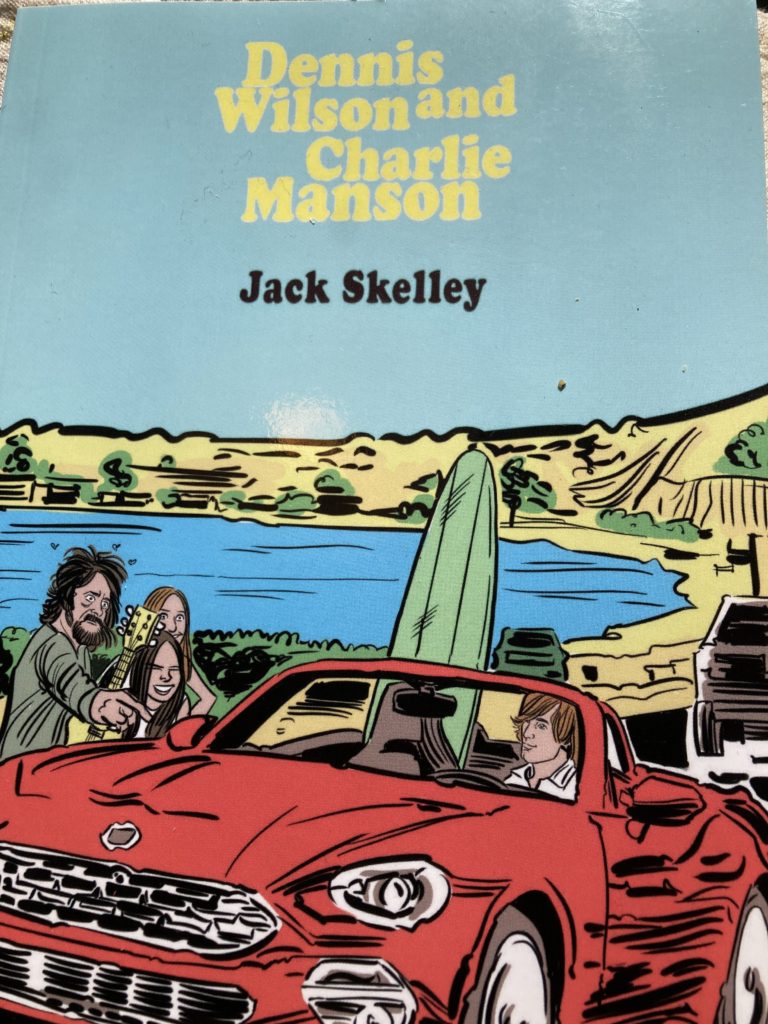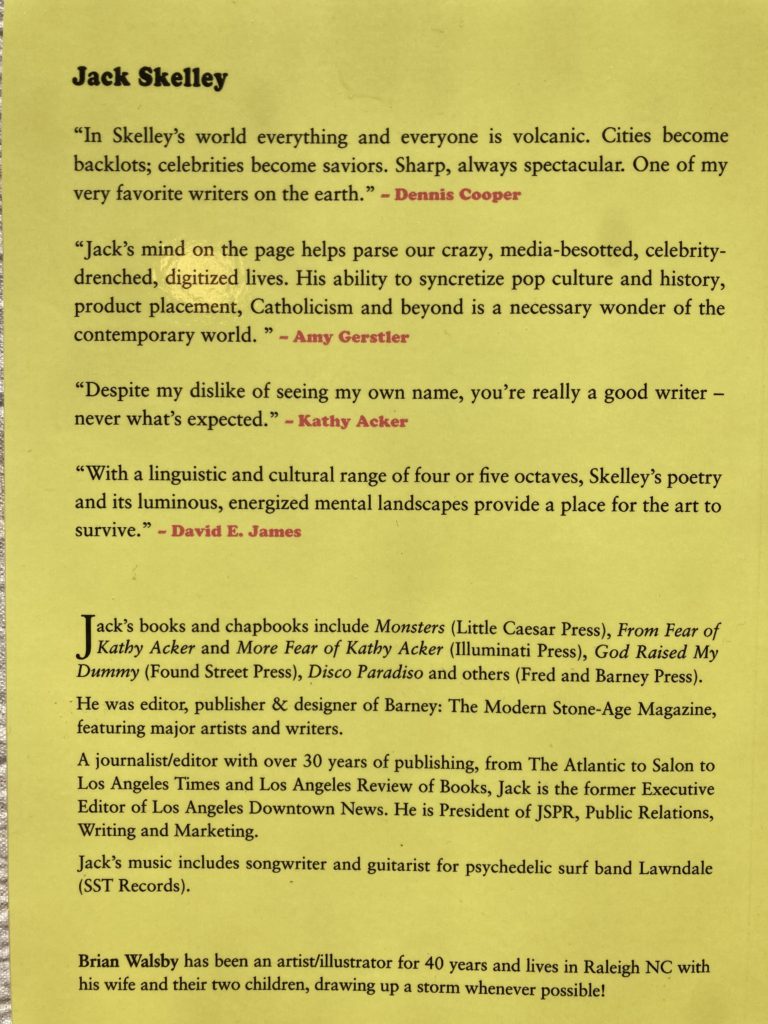
“PLEASED TO MEET YOU, BEASTMASTER 666”: Jack Skelley’s Hybrid Undercurrents of Sunset Blvd.
DENNIS WILSON AND CHARLES MANSON
by Jack Skelley
(Illustrations by Brian Walsby)
Fred & Barney Press, 2021
Laurence Goldstein’s POETRY LOS ANGELES: Reading the Essential Poems of the City (University of Michigan Press, 2014 is without doubt the best book-length commentary about poems that use Los Angeles as a trope. Goldstein’s concisely eloquent phrasing, acute analysis, and knowledge of the city make the book a pleasure to read, even when the subject of a given poem focuses on the grimmest aspects of the so-called counterculture of the 1960s. In Chapter Two, “Hollywood: Here and Everywhere,” for instance, Goldstein contextualizes David Wojahn’s harrowing poem about Charles Manson’s aborted songwriting career as a postmodernist version of Yeats’s “Second Coming.” Instead of vatic apocalypse, however, Wojahn’s music producer protagonist, Terry Melcher, makes history (Wojahn’s italics) a matter of a speech act in popular culture. As Goldstein points out, though, Manson’s conversion of Yeats’s sphinx-like monster into “Beastmaster 666” is not meant to be more profound than any other ideological stick-figure taunt. It is merely a “verbal prop, the sign of a hostile attitude marketable to a bored and rebellious counterculture.”
If it turned out to be a house that Melcher leased in which Manson’s followers carried out his orders for mayhem and carnage on August 8, 1969, it was in the residence of a much better-known pop culture figure that Manson first wrangled an abbreviated audition in the corporate music industry. For several months during the previous year, Manson and his entourage had informally squatted at the Sunset Boulevard home of Dennis Wilson, a singer in the Beach Boys band. The relationship between Wilson and Manson is the focus of a long, documentary-style story with a poetic coda by Jack Skelley that has been published by Fred and Barney Press in Culver City. It is heartening to see Skelley’s return to literary projects, after the long imposition of having to work as a journalist and public relations specialist.
First, though, a bit of literary history: Skelley was part of the Dennis Cooper “gang” at Beyond Baroque that was recently featured in an exhibit at the Huntington Library as part of “MADE IN L.A 2020.” The choice of Manson as a subject for Skelley’s return to literary work is perhaps not without a link to that brief but notorious scene in Venice, California that also included the late performance artist/poet Bob Flanagan as well as poets such as Amy Gerstler and David Trinidad. Skelley’s initial literary successes were as a poet published by Cooper’s small press venture, LITTLE CAESAR. Skelley’s first book of poems, Monsters, was one of the notable first books of poems published in the United States in the early 1980s, and he also became renowned for his adaptations of Kathy Acker’s writing. In addition, Skelley was in bands such as Planet of Toys and Lawndale. Many, many, many, many, many years later (cf: “Flanagan’s poem “Fear of Poetry”), Skelley’s selection of a notorious criminal responsible for several murders as one of his eponymous characters brings to mind Dennis Cooper’s novels, which have been primarily concerned with serial killers or at the very least draw upon our familiarity with such real-life instances.
In contrast with Cooper’s homosexual domain, Wilson’s and Manson’s mise-en-scene in Skelley’s rendition is thoroughly heterosexual and patriarchal in its gender dynamics. “Sexy Sadie,” the opening scene of DWCM reads almost like a parody of a scene that one might imagine at Hugh Hefner’s Playboy Mansion a half-century ago. Though it would seem to be the case that Wilson ended up encountering Manson only because of a brief dalliance with two of his followers, whom he picked up while they were hitchhiking, it is difficult to feel sorry for Wilson, whose id has been done no favors in return for attaining success in the music industry. Like those who win millions in a lottery only to die emotionally and financially destitute, Wilson’s life only takes a turn for the worse after serving as a host for Manson’s parasitical self-absorption.
Skelley’s book itself feels like a truncated Elizabethan tragedy in which acts two, three, and four have been lost. The first three scenes of Act I all take place in the late 1960s, whereas the last two scenes all occur in the final month of Wilson’s life. This temporal collage works to Skelley’s advantage: one doesn’t feel the need to have the intervening years filled out. If they are blotted out, it is because they are obscene in the etymological sense of the word: that which is kept off-stage because mimesis will only harm the viewer.
The most compelling portion of the story is in part three, in which Manson is given a monologue that might well serve as an audition monologue for any actor brave enough to give it full-throated utterance. One can easily imagine Arthur Brown’s hit song “Fire” playing in the background. Skelley has given Manson an equally operatic intensity. As with Milton’s Satan (not to mention Mick Jagger’s), Skelley’s Manson is hard to take our eyes off as his rant breaks water like a shark fin.
When I finished Skelley’s “Dennis Wilson and Charles Manson,” I felt as if I had read a major novel. For those who believe compression can be equal to any epic, this book should find its way to the pile of books on your nightstand, though you should turn on your bedstead lamp only if you prefer to have your nightmare before you fall asleep rather than in 3D REM.
You can order a copy of this book at:
Fred & Barney Press
10768 Northgate Street
Culver City, CA 90230
CONTENTS PAGE FOR “Dennis Wilson and Charles Manson”:
“Sexy Sadie” – Summer, 1968. 14400 Sunset Blvd., Pacific Palisades
“Apple Pan” – Fall, 1968. 10452 Bellagio Road, Bel Air
“Rise” – Spring, 1969. 10050 Cielo Drive. Benedict Canyon
“Birthday” – December 4, 1983, 14400 Sunset Blvd., Pacific Palisades
“Reverb” – December 28, 1983. Marina del Rey
“Epilogue Remix: Beach Boys Villanelle”
(Note: The Hammer Museum provided the other half of the exhibition space “Made in L.A.” In the case of Beyond Baroque, Its complementary programming included interviews with Dennis Cooper, Amy Gerstler, Sheree Rose, David Trinidad and Benjamin Weisman, as well as Jack Skelley interviewing “Beyond Baroque” installation creator Sabrina Tarasoff.)
https://channel.hammer.ucla.edu/video/1692/dennis-cooper-benjamin-weisman-amy-gerstler-tosh-berman-in-conversation
Finally, here is an interview with Jack Skelley by Michael Silverblatt of KCRW’s BOOKWORM:
https://www.kcrw.com/culture/shows/bookworm/jack-skelley-dennis-wilson-and-charlie-manson
Background information:
https://www.biography.com/news/charles-manson-dennis-wilson-friendship

 About Bill Mohr
About Bill Mohr